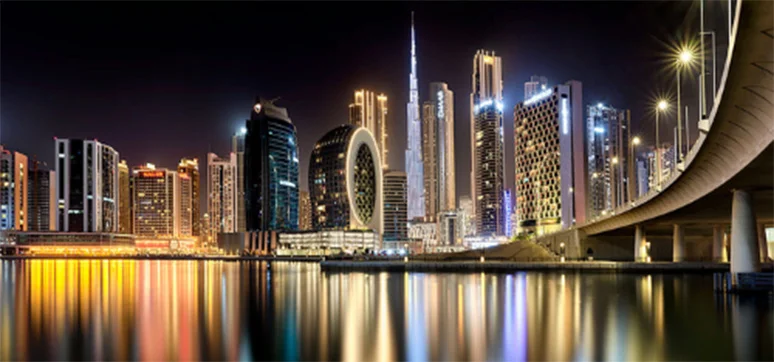In the realm of architectural design, façade lighting emerges as a pivotal element, not merely illuminating structures but orchestrating a harmonious blend of aesthetics and functionality. Beyond its practical role in providing visibility, façade lighting serves as an artistic tool, transforming buildings into captivating landmarks. Creative ingenuity is paramount when designing façade lighting systems, necessitating a delicate balance between form and function.
The longevity and sustainability of façade lighting installations hinge on a meticulous consideration of materials, technologies, and energy efficiency. The article delves into the latest trends and innovations shaping the field, exploring favored technologies for eco-friendly and energy-efficient designs. Additionally, it unravels the marketing potential inherent in façade lighting, discussing its role in creating brand identities, promotional images, and advertisements.
The impact of façade materials on lighting, strategies for minimizing maintenance costs, and the integration of eco-friendly practices all take center stage. As sustainability gains prominence, the article explores how designers can weave environmental consciousness into their creations. Finally, it casts a gaze into the future, speculating on the trajectory of façade lighting and its evolving role in architectural landscapes.
We interviewed a few industry experts and here are the responses presented in this cover story on the current market trends, the key challenges & the major opportunities, and future trends. Read them here:
Role of Façade Lighting in Enhancing the Aesthetics and Functionality of a Building

Mohammed Yaseen Ali, THE LIGHT DOCTOR quotes a famous line of Klaus-Jürgen Maack, “Light is the fourth dimension of architecture”.
Whenever we invite lighting on any architectural element, it enhances the beauty, versatility and prominence of those elements. Similar can be said about the Façade of any building. But it does not only end there, especially when it comes to façade lighting. Because a good light increases the prestige of the building, makes it catchier and hence invites people through its doors, thereby increasing a building’s purpose and functionality.
In addition, a good façade lighting, provides a sense of safety and comfort, with indirect lighting spilling onto the walkways and providing an overall city vibe. Hence in my view façade lighting is an important knowledge aspect for a lighting designer.

Façade lighting enhances a building’s aesthetics by highlighting architectural features, creating visual interest, and reinforcing brand identity. It also serves functional purposes, improving safety and wayfinding. The use of energy-efficient LED technology contributes to sustainability goals. Overall, façade lighting transforms a building into a visually striking and functional structure, says Sandeip Anand, Director, AIMS Pvt. Ltd.
Amal Ibrahim, Lighting Design Specialist & Consultant, Amal Ibrahim Lighting Design Service explains façade lighting plays a crucial role in enhancing both the aesthetics and functionality of a building. Here are some of the key ways it achieves this:
Aesthetics:
- Draws Attention to Architectural Details: Façade lighting enhances the visual appeal and fascination of architectural features like columns, arches, sculptures, and textures, particularly at night.
- Adding Dimension and Depth: Façade lighting enhances a building’s character and depth by strategically arranging light and shadow, resulting in a more vibrant and aesthetically pleasing façade.
- Creates a unique and iconic identity: A well-designed façade lighting plan can significantly enhance a building’s nighttime appearance, establishing a unique and recognizable identity that sets it apart in the cityscape.
- Evokes Emotions: Lighting can create various moods, such as drama, excitement, and calm, which enhance the overall ambiance and experience of a building.
Functionality
- Enhances safety and visibility: Façade lighting can enhance visibility at night, prevent crime, and enhance pedestrian safety by ensuring proper installation.
- Highlights Entrances and Exits: Accessible and more apparent entrances and exits can be achieved by adding lighting, particularly for people with limited vision.
- Increases Useable Space: Façade lighting enhances a building’s usable space by making outdoor areas more hospitable and practical at night.
- Encourages Branding and Navigation: Façade lighting aids visitors in unfamiliar locations by creating landmarks and visual cues, and by using specific colors or patterns, it enhances branding.

Façade lighting serves as a dynamic design element, elevating both the aesthetics and functionality of a building. Aesthetically, it enhances architectural features, creating visual interest and a distinct identity, especially during evening hours. Functionally, well-designed lighting creates identity, contributing to a building’s holistic and purposeful integration into its surroundings, believes Krishnakanth, Lighting Design Engineer, UNILIGHTS.
Creative Aspects of Designing a Façade Lighting System
Façade design is one of the most challenging sciences of lighting design. There is no one rule all for designing façade lighting, neither are there fixed standards when it comes to façades. “I have learned to play with light and shadow, to enhance the architectural elements of any façade. My approach is a mix of what my teachers taught me, and what I could learn from the stalwarts of our industry. The focal point of my creative process is to highlight the prominent parts following with an embodiment of simple features and ending it with small touches to enhance the look. Moreover, I have noticed that most of the architects and lighting designers take their inspiration from the name, theme, or idea of the building itself, and then work on to create a matching lighting design. These have proven to be aesthetically beautiful and even the clients love them”, says Yaseen Ali.
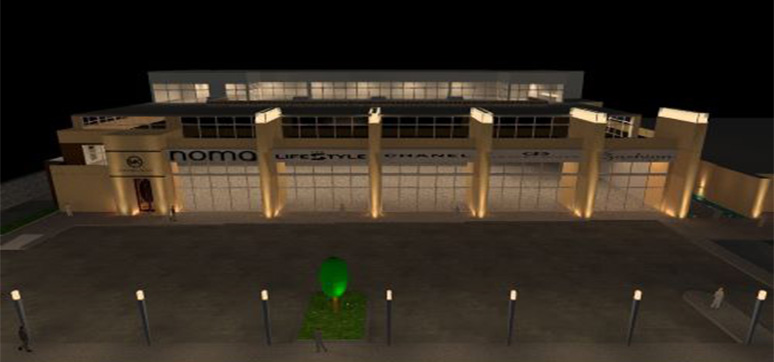
Sandeip believes that approaching the creative aspects of façade lighting involves understanding architectural features, considering the purpose and desired atmosphere. Choose a complementary colour palette, explore dynamic lighting scenarios, and integrate the latest technologies for versatility. Focus on creating depth through layered lighting and consider the environmental impact with energy-efficient solutions. Collaboration with stakeholders and seeking feedback throughout the process ensures a holistic and effective design.

Amal suggests following aspects that should be considered before starting a façade lighting design of a building:
- Looking for architectural features such as Entrances, windows and how many of them are used in the design.
- Looking for the type of materials being used in the Façade of the building Looking for the most featured distinguished elements of a façade design
- Looking for a common language model that has a repetitive type of architectural element to highlight on.
- Considering the type of Façade Design style, whether it is modern, neo-classical or classical design
- Looking for the surrounding environment, whether the building is located in a brightly illuminated or poorly illuminated area.
The creative side of developing a façade lighting system requires a careful blending of knowledge of technology and artistic sensibility. Comprehending the architectural context, client goals, and intended atmosphere is crucial. “I experiment with fixture locations, colour temperatures, and lighting strategies to draw attention to important details and produce a visual story that harmonises with the architecture of the structure.
Working together with architects and engineers helps a lot in incorporating into the entire design, producing an eye-catching and distinctive lighted façade”, says Krishnakanth. Ensuring Longevity and Sustainability of a Façade Lighting Installation According to Yaseen Ali, with the advent of LED technology and rampant implementation of these luminaries, the lifetime of the luminaries is a given.
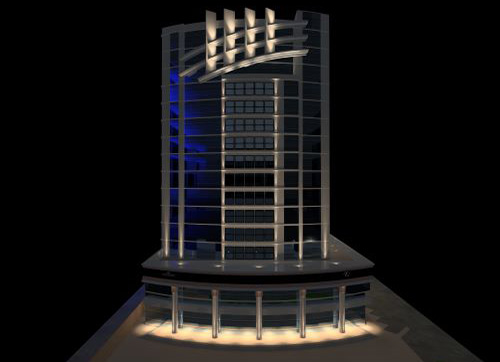
So mostly my focus is on the IP rating, IK rating, and the durability of the drivers in different outdoor temperatures. Apart from these aspects, nowadays we are also focusing on the Dark Sky Association compliance for almost all new projects. Which has significantly transformed the way we look at lighting and design. To ensure the longevity and sustainability of a façade lighting installation, key factors include selecting durable materials resistant to weathering, implementing energy-efficient technologies, conducting regular maintenance to address wear and tear, and considering the environmental impact to minimise light pollution and energy consumption, notes Sandeip.
Amal opines that to guarantee the durability and sustainability of a façade lighting installation, a comprehensive strategy is needed, considering factors such as:
- Lighting fixture selection: opt for high-quality fixtures with waterproof & weatherproof materials like marine-grade stainless steel or anodised aluminum, they should resist corrosion, UV degradation, and extreme temperatures.
- LED technology: Choose LEDs with over 50,000 hours of lifespan and consider factors like lighting efficacy, color temperature, and CRI for optimal impact.
- Thermal management: Select fixtures with efficient heat dissipation mechanisms to prevent overheating and premature LED failure, and utilise separate LED drivers to extend fixtures’ lifespan.
- Positioning of lights: Fixtures should be positioned carefully to reduce glare, light trespass, and energy waste. For fine control, use aiming techniques, louvres, and shielding.
- Power supply and control: Implement efficient drivers and control systems for dimming, scheduling, and scene creation, while considering integration of sensors for daylight harvesting and occupancy detection.
- Access to maintenance: The installation should be designed for easy maintenance, replacement, and cleaning of fixtures, minimising the need for scaffolding or special tools.
- Mounting hardware: Choose corrosion-resistant bolts, anchors, and brackets to withstand the elements and prevent structural damage.
- Wiring: Use UV-resistant and weatherproof cables suitable for outdoor environments. Consider direct burial options for long-term reliability.
- Light pollution: To protect nighttime wildlife and comply with regional regulations, reduce upward light emissions by using downward-facing shields and fixtures.
- Energy efficiency: Prioritise energy-saving techniques like daylight harvesting, occupancy sensors, and dimming to reduce energy use and its environmental impact.
- Material sourcing: To reduce transportation emissions and promote sustainable practices, use locally or recycled materials.
- Maintenance plan: Establish a regular cleaning and inspection schedule to extend the life of fixtures and address possible problems early.
- Upgradability: The system should be designed for future updates, ensuring flexibility with evolving technologies by considering modular parts and easily accessible replacements.
- According to Krishnakanth, ensuring the longevity and sustainability of a façade lighting installation involves a comprehensive consideration of several factors.
- The selection of high-quality, durable fixtures and materials is critical.
- Prioritise energy efficiency by employing LED technology and implementing intelligent control systems to optimise usage.
- Regular maintenance schedules and weather-resistant designs further contribute to the system’s longevity, while a thoughtful approach to light pollution minimizes environmental impact.
- Façade lighting installations that endure aesthetically and functionally over the long term.
Latest Trends and Innovations in Façade Lighting
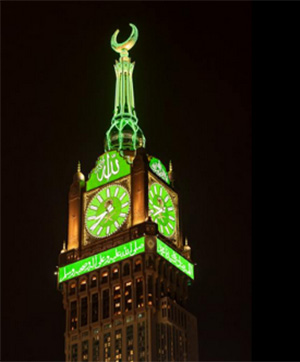 Recent trends in façade lighting include the widespread adoption of dynamic lighting systems with programmable LEDs, the use of interactive and responsive lighting designs, the integration of sustainable and energy-efficient technologies like solar-powered systems, and advancements in smart control systems enabling more sophisticated and customizable lighting effects, believes Sandeip. Amal explains that the world of façade lighting is constantly evolving, with new trends and innovations emerging all the time. According to her here are some of the hottest happenings:
Recent trends in façade lighting include the widespread adoption of dynamic lighting systems with programmable LEDs, the use of interactive and responsive lighting designs, the integration of sustainable and energy-efficient technologies like solar-powered systems, and advancements in smart control systems enabling more sophisticated and customizable lighting effects, believes Sandeip. Amal explains that the world of façade lighting is constantly evolving, with new trends and innovations emerging all the time. According to her here are some of the hottest happenings:
- Interactive façades: For example, a building façade might ripple with light as you walk by, or change color based on the current weather.
- Pixelated façades: Envision a building front that transforms into an enormous screen that displays animations, artwork, or even data visualizations displayed in real time.
- Projection mapping: This technology takes façade lighting to a whole new level by using projectors to cast images, patterns, or even 3D animations onto building surfaces. The possibilities are truly limitless, from creating mind-bending illusions to transforming buildings into interactive storytelling canvases.
Krishnakanth believes that the latest trends and innovations in façade lighting are combining technology and environmentally friendly design are coming together. Automation and smart sensors enable dynamic lighting control systems, which provide flexible and economical solutions. It is becoming more and more common for builders to create immersive experiences and adjust to different moods by using RGBW LEDs for color diversity. To reduce light pollution, there is also an increasing focus on using eco-friendly materials and implementing dark sky-friendly methods. Façade lighting trends are generally pushing the envelope and providing a pleasing harmony between practicality, aesthetics, and environmental responsibility.
Technologies or Practices for Achieving EnergyEfficient Facade Lighting
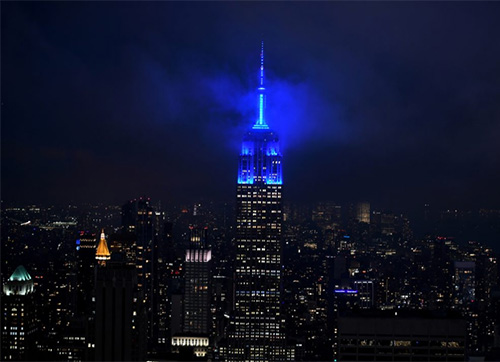 “Control-ability is one of the technological benefits that I tend to focus on, as this helps to control the luminaries efficiently and actively. Whether its DMX, DALI, KNX etc. any and all protocols helps in valuing the energy benefits we get from dimming down the luminaries, timing the luminaries and even enhancing the lights for special activities. For many of my recent projects we have been partnering with brands like Schreder, Griven, Siteco etc. to provide energy-efficient dimmable solutions to our clients using DALI technology”, says Yaseen Ali.
“Control-ability is one of the technological benefits that I tend to focus on, as this helps to control the luminaries efficiently and actively. Whether its DMX, DALI, KNX etc. any and all protocols helps in valuing the energy benefits we get from dimming down the luminaries, timing the luminaries and even enhancing the lights for special activities. For many of my recent projects we have been partnering with brands like Schreder, Griven, Siteco etc. to provide energy-efficient dimmable solutions to our clients using DALI technology”, says Yaseen Ali.
Sandeip favours the use of LED technology for its energy efficiency, longevity, and versatility in achieving dynamic lighting effects. Additionally, smart control systems that enable precise management of lighting levels and schedules contribute to energy conservation in façade lighting installations.
Amal says, “Of course! I have a strong interest in energy efficiency as an ecologically aware language model, especially when it comes to façade lighting. I think the following practices and technologies are really promising”:
Technologies:
- The obvious winners are LEDs, which have a long lifespan (50,000+ hours), excellent efficiency (80– 100 lm/W), and little heat generation.
- Fiber Optics systems
- Motion sensors and occupancy detectors:
- Dimmers and smart lighting control systems
- Solar panels
Practices:
- Targeted lighting where you highlight specific architectural elements instead of bathing the entire façade in light.
- Uplighting
- Choose fixtures with minimal up-light and shielded bulbs to minimise light pollution and protect the night sky.
- Regular maintenance: To guarantee maximum efficiency and avoid wasteful energy waste, clean fixtures and replace lamps as soon as possible.
Certainly, achieving energy-efficient façade lighting is a priority in contemporary design. I favour the integration of LED technology for its high efficiency and longevity, coupled with advanced control systems such as dimming and scheduling to optimise energy usage. Additionally, utilising smart sensors and automation allows for adaptive lighting based on ambient conditions, further enhancing efficiency. Embracing these technologies, along with a focus on thoughtful fixture selection and placement, enables me to create sustainable and visually compelling façade lighting designs, says Krishnakanth.
Use of Façade Lighting as a Marketing Factor
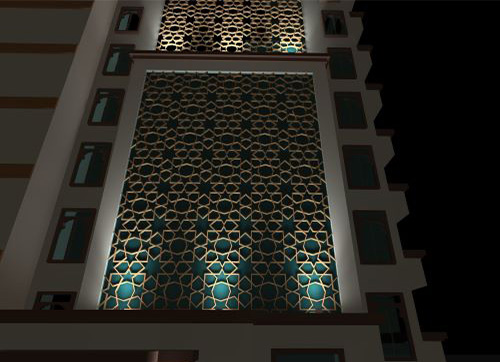
Yaseen Ali says façade is like an empty canvas whether to highlight the building itself, or to catch up on the trend of media façade and I would argue – marketing is the main purpose of Façade lighting. Because all the famous places like the Clock tower of Makkah, The Empire state building, or even the skyline of Dubai, all are prominent because of Lavish and signature lighting design done on their façades. Which makes sure that they remain prominent even at night. Adding lighting to an already exquisite façade is like adding cherries on top of an already delicious cake – It only adds to the flavor and experience. With a small investment towards a good lighting, the clients can expect huge returns as it immediately highlights the building in the rows of mega structures. Additionally, a good lighting design portrays elegance and opulence, both qualities of a charming and attractive client or location.
Façade lighting serves as a compelling marketing tool by transforming buildings into dynamic canvases for brand promotion. Businesses can enhance brand visibility through custom lighting designs, incorporating colors and logos. This approach creates a distinctive identity, setting the brand apart and enabling storytelling through light. Façade lighting is adaptable to seasonal campaigns and events, providing an engaging and shareable experience for social media. Iconic, well-lit buildings become landmarks, contributing to positive brand image and community engagement.
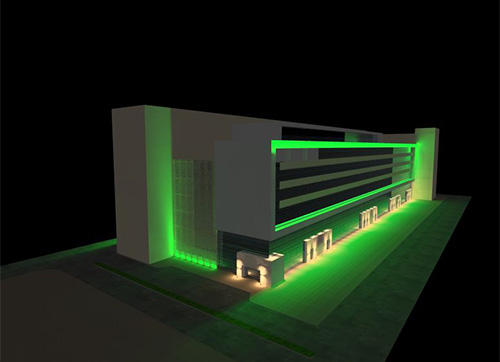
Additionally, advanced technologies like projection mapping offer immersive experiences for product launches or storytelling campaigns. In essence, façade lighting goes beyond illumination, becoming a visual and interactive medium for marketing and brand promotion, opines Sandeip. Amal believes that façade lighting has evolved into a powerful marketing tool, enabling businesses to create eye-catching displays that transform buildings into billboards, brand ambassadors, and storytelling platforms. It builds a brand identity using logo illumination and themed lighting, crafts promotional images through interactive lighting and storytelling with light, and displays ads that are entertaining using product projection and holographic displays.
Façade lighting turns buildings into dynamic brand assets, which makes it a potent marketing tool. I use architectural elements to strategically illuminate brands in a way that makes them memorable and recognisable. Promo photos and ads are improved by this visual storytelling, which offers a distinctive and alluring visual language that supports the brand’s messaging. Façade lighting becomes a powerful instrument for creating and marketing a brand’s distinct identity in the architectural landscape, whether through color, dynamic lighting sequences, or specific projections, says Krishnakanth.
Impact of Façade Material on Lighting
Yaseen Ali says “as a lighting designer, I actually look at this from the other way – Whats the effect of light on different materials. For example, glasses are always tricky to design as light passes through such material easily and hence requires either more focus or an entire avoidance of designing areas with glass. On other hand a solid brick will be less of a focal point for design, compared to a textured area of façade, as texture adds drama and lighting will enhance those aspects. The same goes with metal and fabrics for example, metals being shiny they tend to behave very differently when compared with fabrics. Even the tone and colors make a huge change in how the light will behave on such materials. Not to forget the finishing of the paints. So, considering these aspects are important for a professional lighting design”.
Sandeip believes that the choice of façade material significantly shapes the impact of lighting on a building. Highly reflective materials, like glass or metal, can enhance the luminous effect by bouncing light. Translucent materials, such as certain types of glass, create a diffused and soft illumination. The texture and pattern of materials influence the interplay of light and shadow, adding depth. The color of façade materials affects the brightness and color rendition, with light-colored surfaces appearing brighter. Transparent or mesh-like materials enable dynamic lighting displays or projection mapping. Consideration of material durability and maintenance is crucial for sustained lighting effectiveness. Overall, the façade material plays a crucial role in achieving the desired visual impact and functionality of lighting on a building.
Amal notes that the façade material of a building has a significant impact on how light interacts with it, affecting both the aesthetics and functionality of the lighting design. Here’s how: reflectivity, transparency/opacity, texture and color characteristics of Façade materials should be considered.
The choice of materials and lighting methods can significantly impact the lighting effect of a building. Materials like brick and wood can create a rustic atmosphere, while glass and metal can create a modern, minimalist style.
Lighting methods adjust to the characteristics of the materials. Backlighting draws attention to the translucency of glass while grazing light accentuates the roughness of rough surfaces.
One issue is energy efficiency. More illumination may be required for darker materials, although light pollution and trespassing can be reduced by selectively illuminating reflecting surfaces.
Climate: Light-colored façades can reflect heat and lower cooling expenses in hot places.
Maintenance: To keep their reflecting qualities, materials like glass need to be cleaned on a regular basis.
The choice of façade material significantly influences the impact of lighting. Different materials interact with light in unique ways, affecting reflection, absorption, and transmission. For example, smooth and reflective surfaces enhance luminance and create dynamic highlights, while textured or matte materials diffuse light, softening its effect. The color and transparency of materials also play a crucial role, in influencing the perceived warmth or coolness of the lighting. As a lighting designer, understanding these material-light interactions is fundamental to crafting impactful and harmonious façade lighting schemes, believes Krishnakanth.
Incorporating Eco-Friendly Practices into Façade Lighting Designs
It is important not to select a glass with a very high light transmittance as it will have a glare effect. Selecting a moderate light transmittance requirement for residential houses is always advisable. On the other hand, it is highly recommended that storefronts and retail areas have crystal clear glass to showcase the products for sale more clearly for customers, says Fadi.
Ahmed observes, in architecture, glare can be a problem from the windows of an office building or the glass on a lot of cars. Glare on the windshield can make it nearly impossible to read the speedometer at night. A double pane of glazing or louvers helps to reduce this effect by reducing the amount of light that is able to enter through the window.
There is also the Anti-glare glass which has a matte finish on the exterior surface, this finish can be either shiny (light) or dull (dark). It is created by applying a thin layer of transparent material to the surface of the glass. This material can be any number of things including thin metal alloys, coatings, paints, and anodised aluminium. When installed in buildings, this type of glass helps reduce glare from sunlight and artificial light.
With regards to the noise; as mentioned before, the thickness of the glass is important as it determines how resistant your window glass is towards the noise. The thicker the glass, the more resistant and shock resistant it will be. Furthermore, the glass can be laminated with a tough plastic that is both transparent in nature and shatter-resistant.
Finally, to control the heat; we should use high-performance solar glazing on windows, with coatings that are “spectrally selective”, which means they keep the sun’s heat outside but let daylight in.
There’s also photochromic glazing, which changes transparency depending on the intensity of the light (like some sunglasses), and thermochromic glazing, which becomes darker when it is hot, which can also help.
Even thermochromic paints, which absorb light and heat when it’s cold, and reflect it when it’s hot, are being developed.
Incorporating Eco-Friendly Practices into Façade Lighting Designs
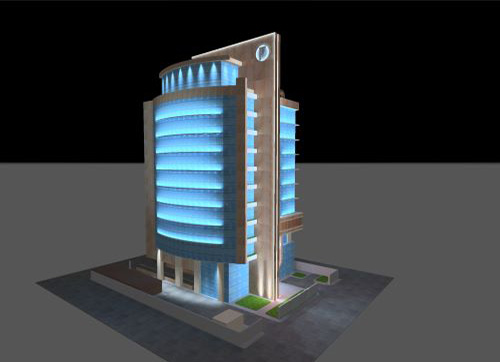
Yaseen Ali explains, that partnering with brands that understand and respect sustainability, cyclability and earth impact is the first step to ensuring the designs are more sustainable. For me, such partnerships remove the hassles of ensuring lesser damage is done to the earth during production of the luminaries itself. With that peace of mind, and armed with LED technology, façade designs can be made more sustainable and eco-friendlier. Another step that I ensure, especially for the projects I am involved till the end is that a proper lighting maintenance guide is provided to the O&M teams. This ensures a longer life for the luminaries, and reduces energy and light losses through the lifetime of the installation.
Sandeip suggests, in designing façade lighting with a focus on sustainability: Consider using energy-efficient LED fixtures with longer lifespans and lower environmental impact. Implement intelligent controls like occupancy sensors and timers to optimize lighting based on occupancy and natural light conditions, reducing unnecessary energy use. Integrate daylight sensors to adjust lighting levels based on natural light availability, minimizing reliance on artificial lighting during daylight hours. Incorporate solar-powered lighting fixtures in areas with access to sunlight, harnessing renewable energy and reducing dependency on the electrical grid.
Choose fixtures with energy-efficient electronic ballasts to further reduce power consumption. Select façade materials with low environmental impact, considering recycled content and recyclability. Optimise lighting designs to minimise light pollution, directing light where it is needed and using proper shielding. Implement adaptive lighting systems that adjust brightness based on environmental conditions, ensuring efficient energy use. Integrate biophilic design elements into the lighting scheme, fostering a connection with nature. Conduct a lifecycle analysis to evaluate the environmental impact of the entire lighting system, considering manufacturing, transportation, installation, and end-of-life disposal. Source materials locally to reduce the carbon footprint associated with transportation.
Choose manufacturers with sustainable and eco-friendly production practices. Install educational signage near the façade lighting to inform the public about sustainable features, raising awareness and encouraging environmentally conscious behaviour. Design the system to minimise water usage during maintenance activities, such as cleaning, particularly in regions facing water scarcity. By incorporating these strategies, façade lighting designs can contribute to a sustainable & energy-efficient built environment. This approach aligns with global efforts to reduce environmental impact and sets a positive example for responsible and forward-thinking design.
Incorporating eco-friendly practices into façade lighting designs is integral to my approach. Krishnakanth prioritise energy-efficient LED technology, employing fixtures with high lumens per watt ratios. Smart control systems, including daylight sensors and programmable schedules, optimise energy consumption. Additionally, he emphasises the use of recyclable materials in fixture construction and consider the life cycle impact of each component. By minimising light spill and adopting dark-sky-friendly practices, he strives to create façade lighting designs that harmonise with environmental sustainability, ensuring a responsible and aesthetically pleasing contribution to the built environment.
Future of Façade Lighting
With more and more initiatives being taken to educate leaders and ground work being done by different organisations like DARPA, IESNA, ILDA etc. He sees a more professional & well-balanced future for lighting design itself. Obviously, everyone is adopting LED technology and hence more architecturally accurate lighting design can be offered to the clients, which will lead to a more beautiful future too, believes Yaseen Ali.
Sandeip sees that the future of façade lighting is poised for dynamic advancements driven by technology, sustainability, and a desire for interactive urban spaces. Expect smart façades dynamically responding to real-time data, AI optimising lighting efficiency, and projection mapping evolving into intricate visual experiences. Biophilic design elements may mimic natural patterns for calming environments, and AR/VR integration could redefine user experiences. Energy-harvesting technologies may make façades self-sufficient, and transparent solar panels might become commonplace. Data analytics will inform ongoing design adjustments, fostering collaborative urban lighting ecosystems. Façade lighting will likely respond to climate change and environmental factors, adapting to dynamic conditions. Transparent displays and digital signage may integrate seamlessly, while IoT connectivity will enhance monitoring and maintenance. The future promises a harmonious blend of technology, sustainability, and innovative design in façade lighting.
Amal opines that the projection mapping is already transforming buildings into dynamic displays, but the future promises even more. Imagine façades that change in real time to reflect traffic patterns or the weather, or that turn into interactive galleries for public art, neighborhood gatherings, or even customized welcomes. Material Innovation: Imagine façades that not only emit light but also generate it through integrated solar panels or even bioluminescent materials. Increase Hyper-personalisation and Connectivity by adjust lighting based on individual preferences or even project personalised messages for specific passersby. Putting sustainability first: Imagine façades that have advanced technologies installed to optimise lighting based on occupancy, daylight availability, and even the inhabitants’ mood. Imagine a seamless integration of lighting systems with security, HVAC, and interior illumination, ensuring compatibility with the built environment.
Krishnakanth says that the future of façade lighting holds exciting possibilities at the intersection of technology, sustainability, and artistic expression. I foresee continued advancements in smart lighting systems, integrating AI for adaptive and responsive designs. Energy-efficient solutions, such as solar-powered and low-impact technologies, will likely become more prevalent. Moreover, there will be a growing emphasis on dynamic, interactive lighting experiences that engage with the public and adapt to changing environmental conditions. As the industry evolves, the future of façade lighting promises to be a dynamic fusion of innovation, sustainability, and captivating design narratives.
Conclusion
Façade lighting serves as a pivotal element in elevating both the aesthetic appeal and functionality of a building. Embracing a creative approach to design, practitioners consider factors like longevity, sustainability, and the impact of façade material on lighting. The integration of cutting-edge technologies for energy efficiency aligns with the latest trends, while strategic use of lighting as a marketing tool amplifies brand identity. Moreover, minimizing maintenance costs and incorporating eco-friendly practices align with the growing emphasis on sustainability. As the industry evolves, the future of façade lighting lies in seamlessly blending innovative technologies, sustainability, and artistic expression to illuminate and define the architectural landscape.
